I just completed a new saxophone video lesson entitled “The Best Embouchure for Tone, Intonation and Endurance Lesson” in which I teach my approach to the saxophone playing embouchure and playing the saxophone. While working on the sax lesson, I thought it would be a cool idea to search the internet for good photos of famous sax player’s embouchures. The photos I found are below.

The Best Embouchure for Tone, Intonation and Endurance Lesson Only 9.99
The word embouchure means “the way in which a player applies the mouth to the mouthpiece of a brass or wind instrument”. There are probably as many variations of embouchures as there are saxophone players in the world. Each a little different, each a bit unique. The goal of my lesson and this article is to see what commonalities we can find. In my video lesson I am teaching my opinion and approach to embouchure based off of what I have learned and noticed through my many years of playing the saxophone. Here is the description of the lesson:
In this new video lesson, The Best Embouchure for Tone, Intonation and Endurance Lesson, I give you the inside scoop on my approach to the saxophone embouchure. I talk about my journey with different embouchures and when I realized that there was a better way to play my sax in regards to the embouchure. I teach you how this type of embouchure effects your tone, intonation, sub-tone and endurance. I show you first hand how to do it and talk about how to practice this type of embouchure. Lastly, I will be posting a blog article with photos of great players like Dexter, Coltrane, Brecker, as well as many others doing what I believe is exactly what I am teaching in this video.(37 Minute Video Lesson)
*The teachings in this video on playing the saxophone are based on my experience. They are based on my opinions that have been formed over many years of playing and teaching the saxophone. I understand that others might approach embouchure, tonguing, voicing and playing the saxophone in a different way entirely and that is ok. This lesson is based off of the approach that I have found to be the best for me and hopefully it will benefit you as well. Steve
Dexter Gordon Embouchure-Lady Bird Video
The photo above is taken from the iconic Dexter Gordon video on Youtube of Dexter playing on Lady Bird. This is my “go to” video when I am teaching a sax student about the embouchure. Notice the bottom lip and the downward tilt of the head. Watch the video and you will see the effortless movement of Dexter’s lower jaw as he sub-tones. All these topics are talked about and illustrated in my lesson also. You can see a sample of the video lesson here when clicking on the lesson sample tab.
John Coltrane Embouchure
John Coltrane! Notice bottom lip and slight downward tilt of the head.
Another John Coltrane Embouchure
Johnny Griffin Embouchure
Johnny Griffin! Not as much of a downward tilt of the head but notice the bottom lip and bottom jaw retracted in what looks like a sub-tone position.
Benny Golson Embouchure
Benny Golson with a similar bottom lip. So far the four great tenor players above all have bunched up chins! I don’t know about you, but I was taught by a few sax teachers not to bunch up my chin but to point it down and try to make it flat. Interesting!
Coleman Hawkins Embouchure
Coleman Hawkins with a similar bottom lip and bunched up chin. If you would like more info on this approach to playing check out my 37 minute video lesson below where I talk about it in depth as well as it’s effect on tone, intonation, sub-tone and endurance.

The Best Embouchure for Tone, Intonation and Endurance Lesson Only 9.99
Sonny Rollins and Coleman Hawkins Embouchures
Two Tenor giants! Coleman Hawkins along side Sonny Rollins! Wow! Notice Sonny’s bottom lip rolled out.
Gene Ammons Embouchure
The incomparable Gene Ammons with a rollout of the bottom lip. Where is your bottom lip when looking in a mirror while playing?
Young Michael Brecker Embouchure
The amazing Michael Brecker with a slight rollout and a bunched up chin. Michael has a thinner bottom lip than other guys but you can still see it slightly rolled out……..
Middle Aged Michael Brecker Embouchure
….and again……slight rollout and bunched chin……… Question: How much pressure does it look like Brecker is putting on that reed in this photo?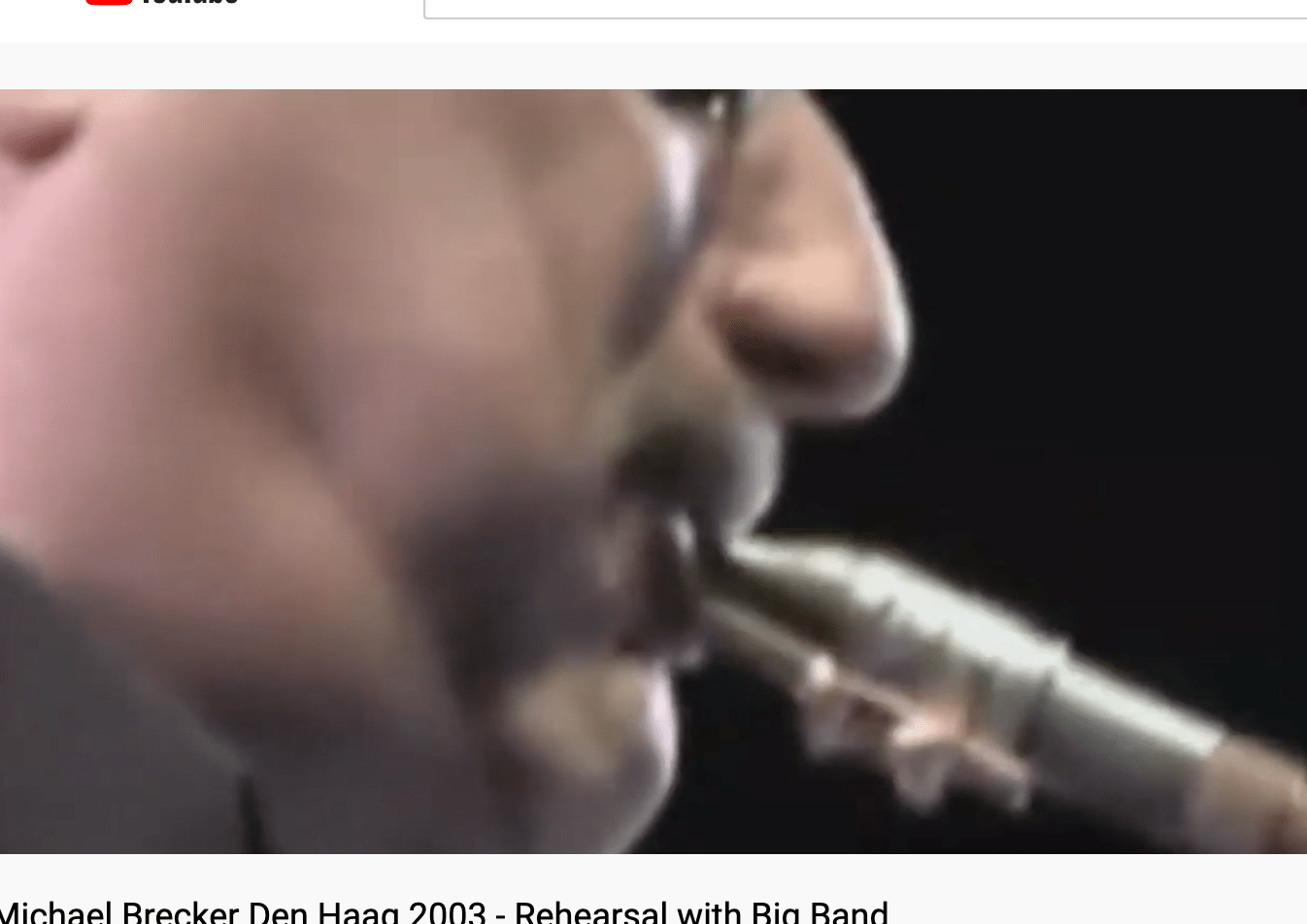
Michael Brecker Embouchure in Full Sub-tone
….and again in full sub-tone. Not the best photo but look at that bottom lip!
Max Ionata Embouchure
One of my favorite tenor players, Max Ionata! Slight downward tilt of head and rolled out bottom lip……. If these help get a tone like Max’s tone. Then they are certainly worth trying out! Don’t worry about the mouthpiece yet, try experimenting with what they do first…..
Bob Mintzer Embouchure
Another of my favorite tenor players…. Bob Mintzer…….. downward tilt and rolled out. Bottom jaw looks pulled back.
Chris Potter Embouchure
…..let’s not forget Chris Potter……..see the bottom lip and bunched chin muscles.
Young Joshua Redman Embouchure
Young Joshua Redman with downward tilt of the head and rolled out lower lip.
Middle Aged Joshua Redman Embouchure
same with middle aged Joshua Redman…..
Mark Turner Embouchure
Mark Turner. Sax sits a bit higher but that bottom lip is most certainly rolled out a bit. Mark Turner always seems to have perfect posture!
Jerry Bergonzi Embouchure
The amazing Jerry Bergonzi. No slight tilt of the head for Jerry in this photo but you can see some of the red of the bottom lip.
Charlie Parker Embouchure
Let’s get some alto players in here. Charlie Parker…….. No downward tilt for Bird but I see plenty of bottom lip!
Cannonball Adderley Embouchure
Cannonball Adderley………
Another Cannonball Adderley Embouchure
Phil Woods Embouchure
One of my idols when I was a young alto sax player in high school, Phil Woods! You can see his bottom lip and bunched up chin……..
Paul Desmond Embouchure
I was curious about Paul Desmond as he has such a different and unique sound. But even with Paul Desmond you can see a downward tilt of the head and the bottom lip rolled out slightly. His chin does look a bit pointed here in this photo though.
Kenny G Embouchure
Finally, To close the discussion once and for all, the incredibly “smooth” Kenny G. You can see the slight roll of his bottom lip in the photo above. In my lesson below, I talk about the importance of thinking of the embouchure gripping the mouthpiece from the sides and not from top to bottom. Kenny G might not subscribe to this teaching of mine though because he always looks like he is smiling when playing in this photo and many others I have seen with the corners of his mouth pulled back. That’s ok though, he is Kenny G and what do his fans want to see? Of course, Kenny smiling at them while playing the most loving melodies and lines dripping with smoothness and emotion. It would make any heart melt at the very thought. (Except you hardhearted smooth jazz haters of course……)
That is it! If you want to find out more about what I teach students in regard to embouchure, tone and intonation check out the 38 minute video lesson below. Thanks for tuning in as we all talk about interesting saxophone topics. See you next time…….. Steve

The Best Embouchure for Tone, Intonation and Endurance Lesson

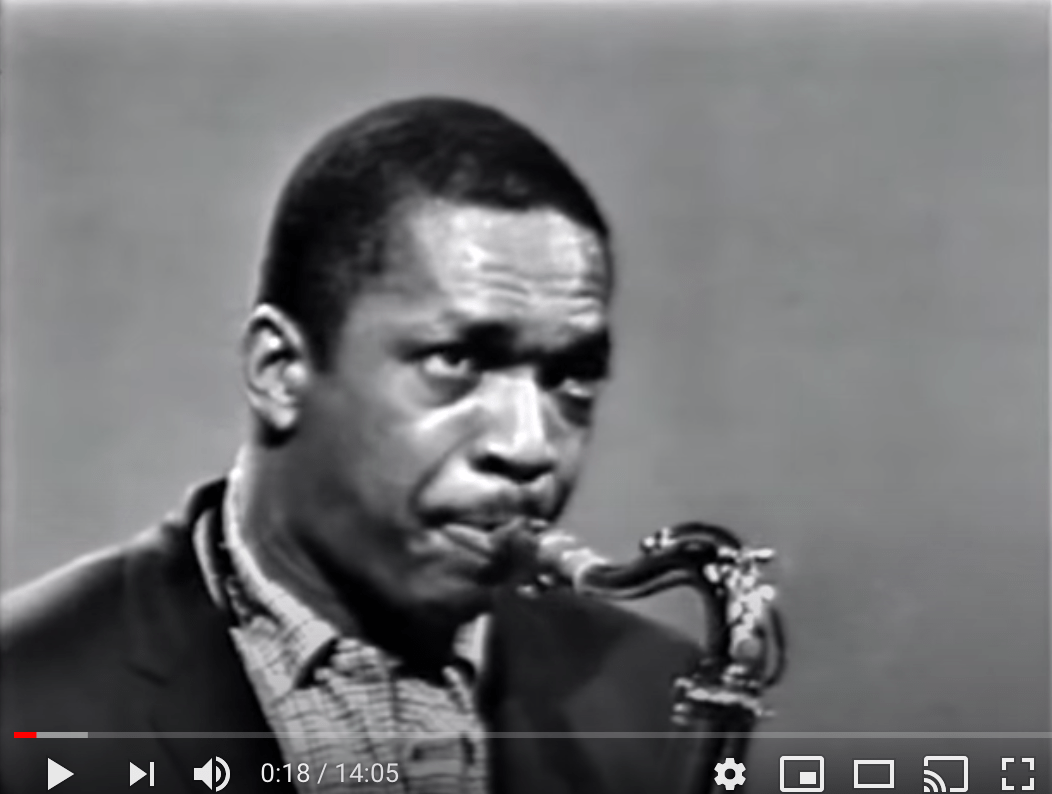



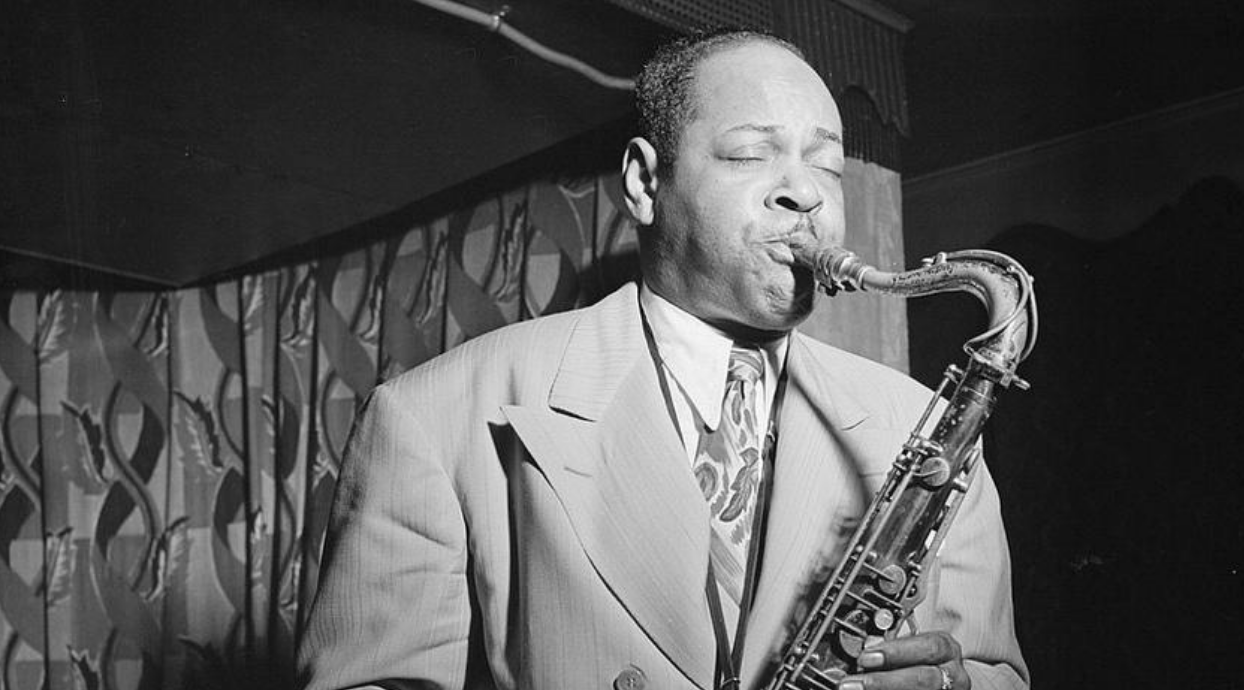
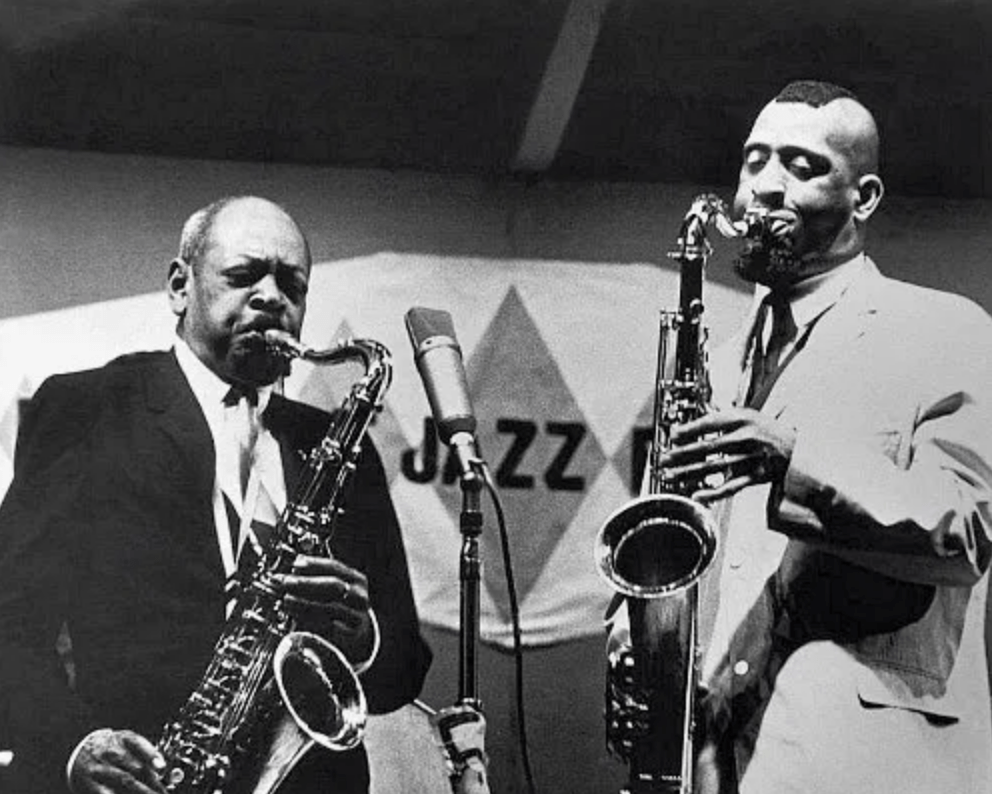
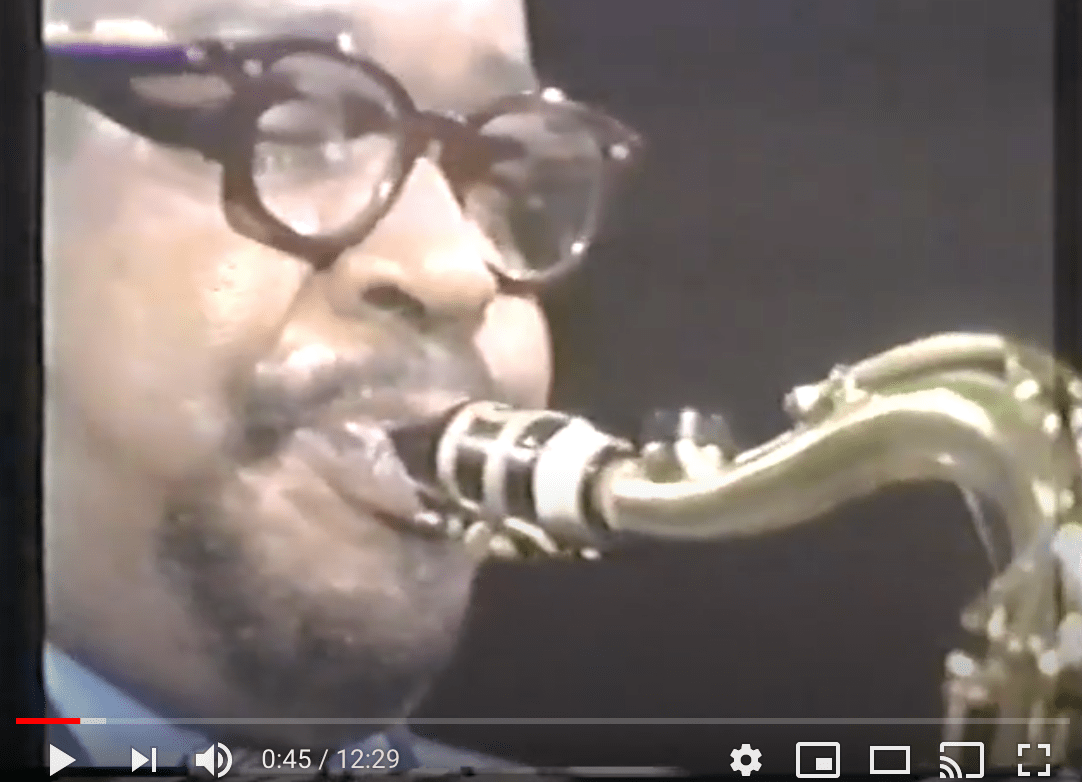




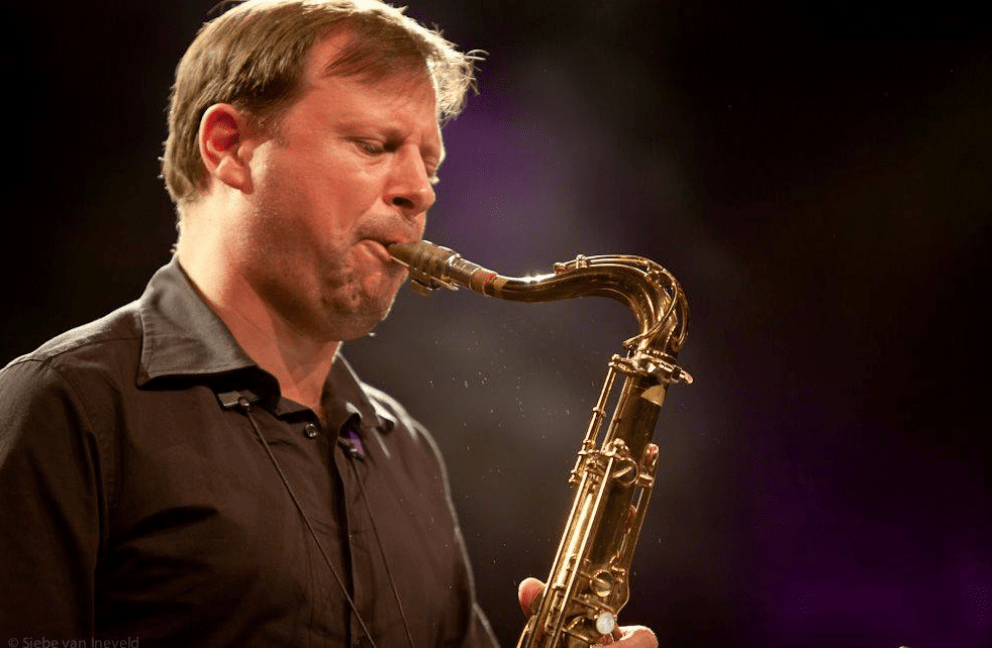
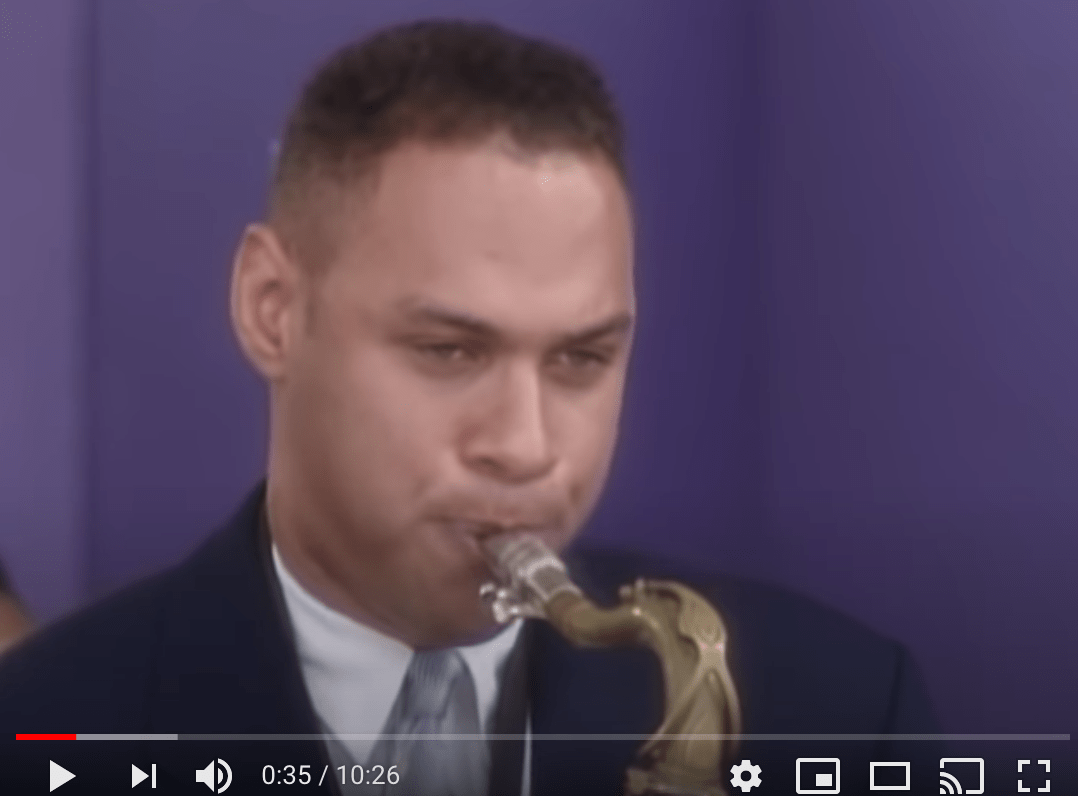
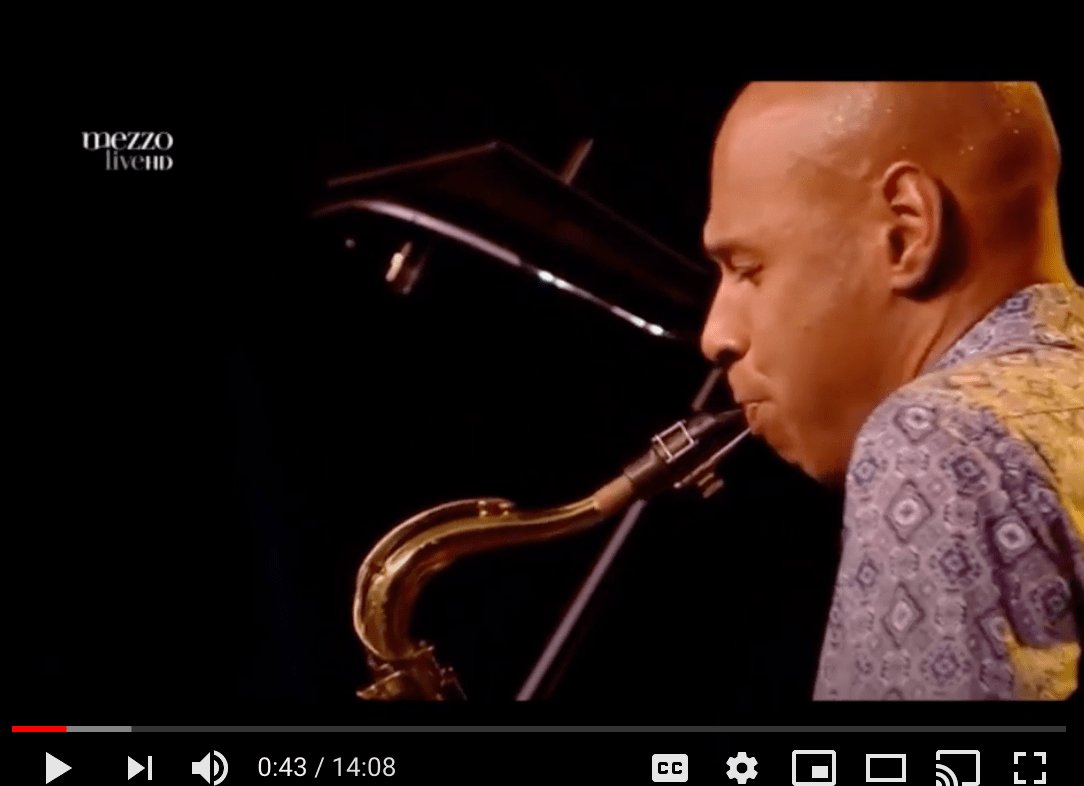
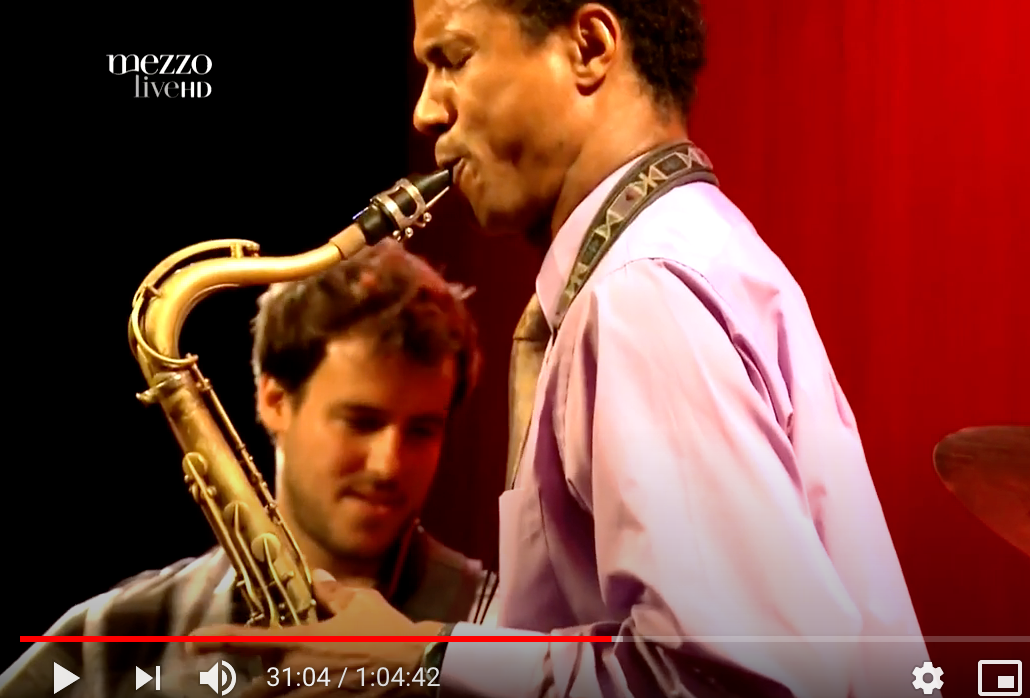


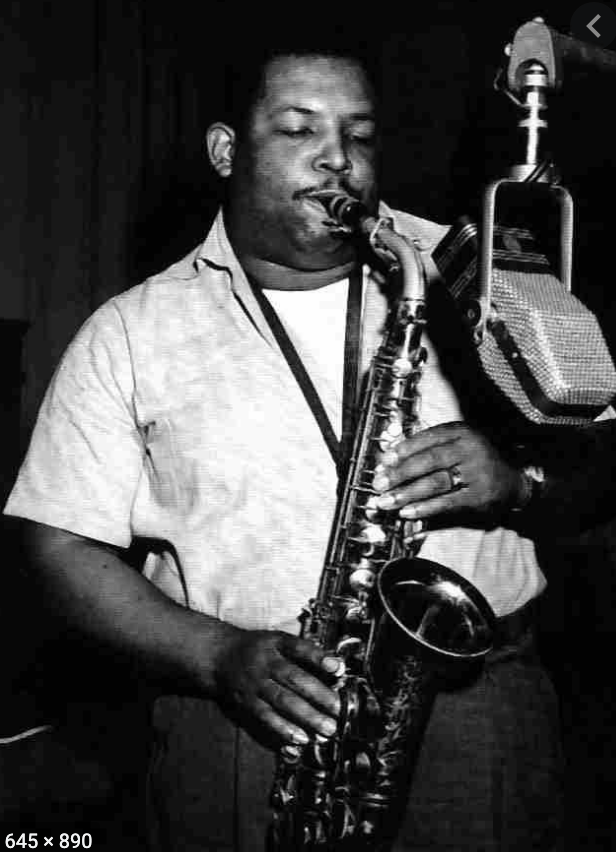

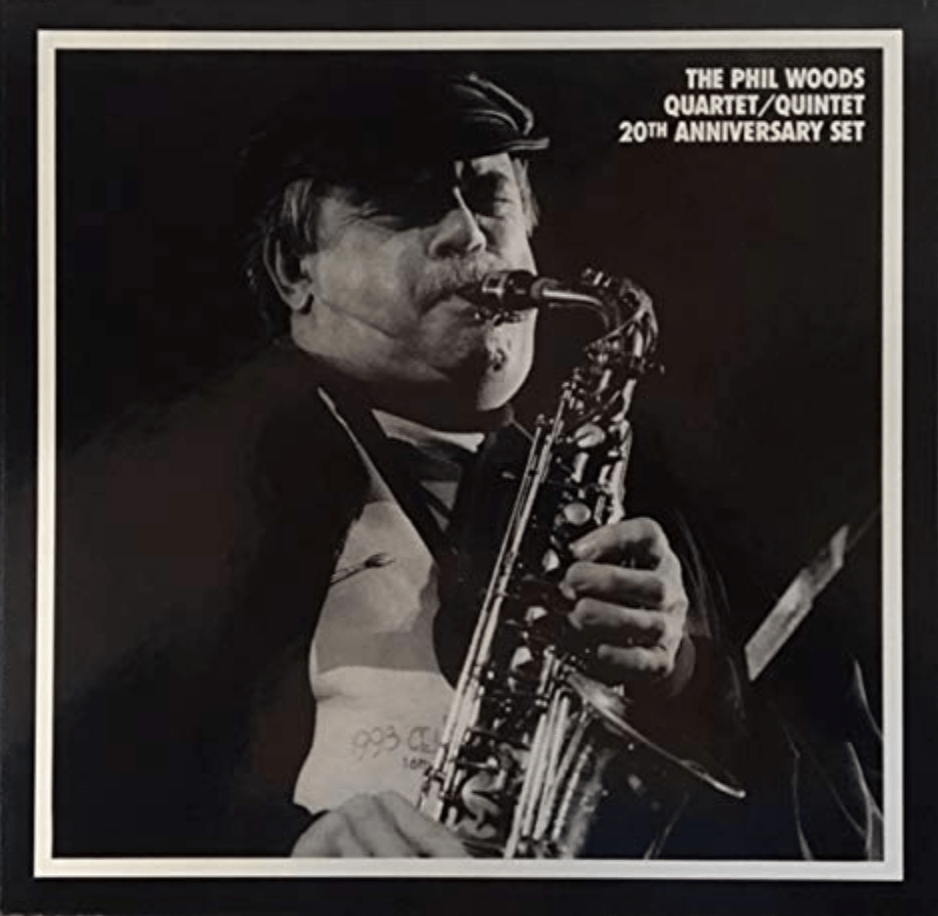
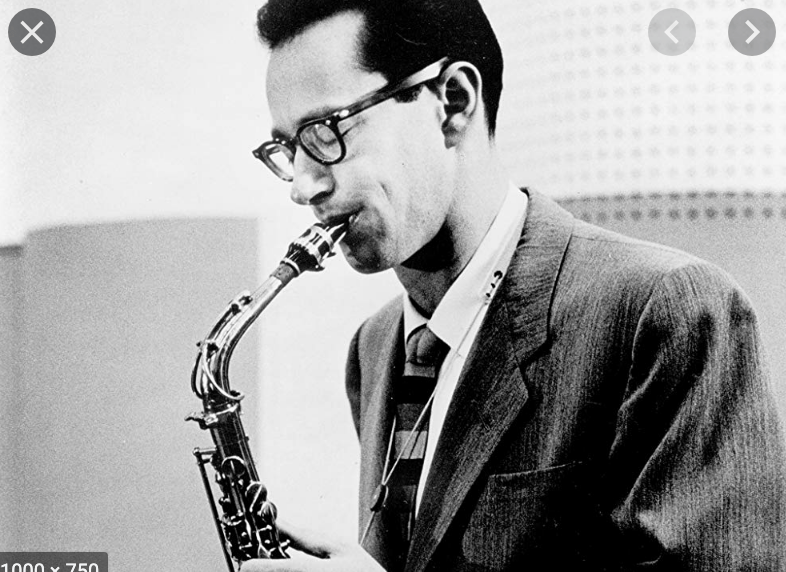

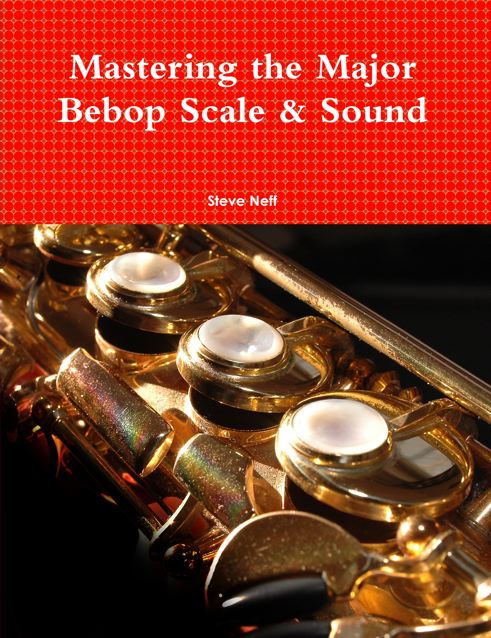


Wow! So cool to see all the pictures back to back. Thanks for all your hard work! Embouchure is such a complex topic to discuss…so many nuances. In my years of teaching there have been some universals. IMHO In every picture it seems that corner strength is evident. Until corner strength is achieved, bottom lip flexibility is very difficult. The funny thing is, all the amazing verities of tone color need for jazz is not possible with out the flexibility in the bottom lip. Also, when corner strength is not there the embouchure becomes very tight and the reed doesn’t vibrate. I read some where that Coltrane used to practice mouth exercises when not practicing to build up his corner strength. The tu ee exercise. Just some thoughts. Thanks again man for your great blog!!
Regards
Mike
Thanks Mike! Glad you like the site and it can be of help! Steve
Ok, I’m in for $10. I have a feeling that, yet one more time, I’m going to learn that long tones are the way forward. It looks like all those embouchures of the pros work because they have the muscles to not need to bite.
The muscles are built over time and practice. It doesn’t have to be just long tones but having the embouchure in the correct position and then spending hours playing builds up the necessary muscles.
Ok, I’m in for $10. I have a feeling that, yet one more time, I’m going to learn that long tones are the way forward. It looks like all those embouchures of the pros work because they have the muscles to not need to bite.
Thanks for supporting my work David. I appreciate it. As I talk about in the lesson, the muscles around the embouchure are vital to supporting the embouchure and taking off pressure from the teeth supporting the bottom lip. Without those muscles engaged you just have a bottom lip on top of the bottom teeth or leaning against the bottom teeth while being pressed into the teeth. Doesn’t feel great……. Steve
This lesson has nothing to do with long tones but is about the physicality of embouchure and what players should try doing to see if these things benefit. The benefit for me was huge so that is why I chose to continue playing like this and teaching these topics.
I’ve changed a bit during the years. I’m much more relaxed with overall pressure. The thing I see many players doing is moving their jaw in and out as they go from high to low pitch. At a masterclass I asked Chris Potter if that was a technique someone taught him and he said not really. He said he does know he does it, but doesn’t remember being told to do it by a teacher. It’s a question I asked about on a sax newsgroup and really didn’t get a good response about why people do it. I do it for sub tone, but not very much for the rest of my playing and I still get a lot of compliments on my tone. Some of the greats move their jaw in and out drastically. Can you tell me what this is supposed to accomplish?
I move my jaw in and out quite a bit. I talk about it in the video lesson quite a bit. The angle the mouthpiece enters the mouth and the angle of the bottom teeth in relation to the lip and reed all play a part in that movement. I don’t remember being taught that either but I do do it all the time. It is tied to the coloring and shape of the tone in my mind. Steve
The single most influential thing any sax teacher ever taught me about making a good sound was to think of my embouchure as a drawstring around the mouthpiece. This was entirely jazz focused, but I bet it could be applied to the classical world as well. I kept doing this all through my studies in college and my teacher (a great jazz and classical player) never once tried to change it – in fact he did something very similar.
This one small piece of advice completely eliminated my line of thinking that I had to bite down on the reed. These photos and your comments seem to back that up.
As for the others who have mentioned moving the lower jaw and lip – I do this too, but for me it’s about color, inflection, and sometimes a slight intonation adjustment. I certainly didn’t do this as a beginner (30 years ago…ack!), but it came along over time as I started to find my saxophone voice about the time I was in college.
The downward tilt of the head is a mnemonic for the weight of the head to be lightly resting on the top of the mouthpiece beak (another great reason for a mpc pad). That frees the lower lip to be much more flexible, and then the side-mouth muscles stabilize the mpc in the mouth. The only real pressure applied to the reed is when you move the jaw or roll the lip for various tonal changes.
Exactly!! I talk about that in the lesson. It frees up the lower jaw even more.
What, no Sanborn conversation? Of all the embouchures on the planet his has to be one of the most radical – with the signature back head tilt and side saddle lip. His alto tone has to be one of the most emulated in the last 25 years and the gold standard for hard edged funk – and the most difficult to copy physically (and why would you try). But he does maintain the lower lip extension which is probably the key for his signature expressive tone. Interesting article. Thanks Steve,
Sanborn is going to be dealt with in another article. I already have the photos lined up………
Thanks Steve,
I have a lot of observational spirit and also a certain ear applied to the observation of the mouth movements of famous or less famous musicians: therefore, since I was a beginner, I instinctively “copied” this relaxed (as it seems to me, for example in Dexter Gordon and Charlie Parker) mouthpiece embouchure…
So relaxed that I use the double lip embouchure…
I hated to put my teeth on the mouthpiece… How can you play if your skull gives you up so much that you don’t hear what you play? And then if you don’t press your teeth the sound increases without being strangled.
And the pads to stick on the mouthpiece seemed like a foreign body in my mouth…
In agreement with the article: never pressure on the reed.
When you play you don’t have to struggle, you have to “breathe”.
When an article about famous musicians who used, or use, the double lips embouchure, now practically no longer used (they forbid you at the conservatory)?
I hope I have not written nonsense for my poor knowledge of English.
Giuseppe, You should really get the video lesson I made on this subject. I think it is a mistake to go as loose as possible and I talk about that in the lesson. I was taught by some great sax teachers who taught me to have a firm embouchure with pressure from the sides coming in. In all these photos you see a lot of facial muscles engaged and the chin bunched up. I think these guys are also using a firm embouchure although I can’t prove that. Once your embouchure is set and solid then you can experiment with loosening it up a bit and see if you like the results.
The other problem with the “loose as possible” embouchure is that you lose some control of the reed. When you have a firm embouchure (not biting or tight) the slightest adjustment or manipulation by the bottom lip or jaw affects the reed immediately. Not so much with a loose embouchure. Watch the lesson if you want more details. Steve
I do not quite agree with what I read about very strong and tense muscles (if I have translated well): it seems to me that, except for Coltrane who seems to “force” and, perhaps, someone else, these muscles are yes strong for exercise, but relax to the max …
Giuseppe.
I would disagree with this. In every photo you see muscles engaged and working around the embouchure. The muscles are what should be supporting 90% of the bottom lip for me. Even when I sub-tone the muscles are engaged and supporting that lip. I think even more so, actually!
Hey Steve, Charlie Parker also sometimes took the mouthpiece to the side, demonstrating the low pressure on it; a little is also seen in the Charlie Parker photo of this review!
Thanks, very interesting review!
Giuseppe.
Yes Steve, I explained myself wrongly: I meant to say that the pressure on the reed and on the mouthpiece seems relaxed to me; I agree that automatically a lot of facial muscles are engaged and the chin bunched up to have a firm embouchure with pressure “from the sides” coming in. I know that it is necessary using a firm embouchure.
I would like to buy the book but I don’t use credit cards: is it found in bookstores in other countries?
Giuseppe, it’s not a book but a video lesson where I teach my approach to embouchure and all that it entails. It is in English though, but you seem to do pretty well when writing so I think you would be ok watching it.
Steve write: “I would disagree with this. In every photo you see muscles engaged and working around the embouchure. The muscles are what should be supporting 90% of the bottom lip for me. Even when I sub-tone the muscles are engaged and supporting that lip. I think even more so, actually!”…
I agree, the muscles “from the sides” are what should be supporting 90% of the bottom lip, even in sub-tones (I have no problems in sound and specially in sub-tones); I hope I have explained!
Giuseppe.
Steve, we didn’t understand each other since I meant that the lower lip was (relatively) relaxed and you understood the lateral facial muscles that support it! It is clear that they are under stress, when you stop playing sometimes you feel them asleep for lactic acid!
Giuseppe.
I will try to order your video lesson in the library of the Villaggio Olimpico Auditorium of Roma (Auditorium Parco della Musica), some meters from my home; possible they order the video lesson on line for me!
Thanks,
Giuseppe.
Steve,
Thank you for this blog, your video lesson, and post on SOTW, which drew a lot of interesting comments including about the bottom lip being sort of a sling for the reed. In these discussions, there does not seem to have been mentioned the idea of doing the mini smile and then putting the mpc in the mouth. This makes sense because the smile then sl tenses/stretches the lower lip and supports it from side to side. You see this indentation on the sides of the mouth in many of the pictures you list suggesting this is what is happening.
Anyway, Steve,
I didn’t want to argue with you, as it often seems; honestly I admire you a lot and I also consider you a kind, correct and nice person, but I would just like to say that, without taking anything away from what I have already explained and clarified, each mouth is different: my lower jaw, for example, is more protruding than it should, while others have the upper dental arch too protruding…
My sax teacher, assertor of the classic embouchure, asked me not to say that I study with him for my double lip embouchure which I refuse to abandon; it is enough that I once a time make a slightly out of tune note which is automatically the fault of the double lip that does not give control ….; however, to my answer, namely that also his other students who use the classic embouchure make notes out of tune, he had to admit that it is true…
It is also true that, among all his other students, that I have known doing the workshops, the best sound is mine…
Every now and then he comes up to me and bangs me on the neck of the sax to show that I don’t hold my mouthpiece tight enough to have complete control … it is clear that, seeing a knock arriving on my mouth, I release the muscles to avoid the trauma: somehow even those who (there are famous musicians, one nicknamed “the sound”, who used this double lip embouchure) use this technique has its own intuitive mechanics and that perhaps can not explain, which somehow works well; better, for me, than the one with the teeth on the mouthpiece which, for a certain time, I tried with dissatisfaction and bad results.
I read something about Joe Allard but I didn’t understand very well … but it seems to me he said that everyone is a different case to which to apply his theories; but I may have misunderstood.
I also read that Coltrane, at some advanced point in his career, seems to have switched to double lip embouchure for his severe pain in his teeth.
But I can say that I have often listened in small jazz clubs, in Rome, since the 70s, live, the famous American clarinetist, saxophonist and pianist, Tony Scott https://it.wikipedia.org/wiki/Tony_Scott_(musicista),
winner in America of an award as first American clarinetist, who played with Parker and Billy Holiday and who, then, traveled the world dying in Italy.
In a documentary film dedicated to him and broadcast on an Italian national RAI network, I learned that, to someone who asked him how he managed to have that unique and powerful sound, he answered by opening his mouth: he had only one, single tooth, in the center of the upper dental arch…
A friend of mine, in the 90s, participated in a Michael Brecker sax seminar in Italy: he told me that Brecker said that both methods, classic and double lip, were fine: with the first there was more control over the sound, with the second the sound was more beautiful…
If a musician gets along well with a method and then manages in some way, that even he cannot explain because instinctive, to control the sound equally, and, probably, perhaps best, why should he suffer to change?
Giuseppe.
I know that Stan Getz, ” The sound”, of which, I read, Coltrane said that everyone of us would like to play like Stan Getz, switched from double lip to classic embouchure, but the recordings I like are the first, like ’50 and ’51: Yvette, Wild Wood, Melody Express, Penny, Potter’s Luck, Split Kick, Rubberneck, Mosquito Knees, Sweety Pie, Ershey Bar, Tootsie Roll, For Stompers Only.
I must also say that the sound that he had developed some time before dying, using a Meyer long shank #7, but I don’t think for the mouthpiece, I liked it a lot and it was much more “hard” than his usual style.
Giuseppe
That’s a good point – one needs to explore what embouchure works best for you, as we are all different. There may not be one size that fits all. From this history lesson of sorts, we learn even the great players have used different embouchures at times.
Forgot to mention that the reason my music teacher gave for doing the mini smile was to take pressure off the sides of the reed which could dampen its sound.
So there are many different aspects to this embouchure story.
Walter,
I thank you for your solidarity and patience in reading what I have written; I think that in general, what is taught in conservatories and what Steve explains, are interesting and important notions that, in the 99% of cases, are needed and work well. However, each person is different, and the general approach must be considered specifically for the person in question; in fact I, for some time, tried the classic mouthpiece embouchure, but then I chose the double lip embouchure. If nobody made their own choices, perhaps there would be slower progress; we would still play dixieland … perhaps such personal choices also involve technical errors for some, perhaps for me: everyone tries, then takes on his responsibilities and consequences.
If I remember correctly, I could be wrong, even Waine Shorter used double lip.
It may be that, if my first sax teacher had forced me to use the embouchure now considered classic, I would find this technique comfortable; or it may be that I would have changed the instrument, not bearing it.
Then, the double lip does not mean that the upper teeth are not resting on the mouthpiece, but only that they rest on it with a layer, more or less high, of the inner skin layer of the upper lip…
I think, however, but I may be wrong, that this is the same technique that clarinetists and many saxophonists used before the music conservatories began to ban it for saxophonists.
Watch this video in full screen: towards the end, after the battery solo, at about 4:00 minutes https://www.youtube.com/watch?v=mZ5eGEest0g
Charlie Parker holds the mouthpiece to the side of his mouth, which seems to hang like a cigarette… Do you seem to notice that the lips are under strain? I say the lips, not the lateral facial muscles.
If this can comfort you, Charlie Parker doesn’t “smile” while he plays; the tips of his lips are pointing downwards; like those of many other famous, and not famous, saxophonists.
I hope I have not been a “bad teacher” and, in any case, I affirm that what Steve expounds is right and exact and necessary for the majority of saxophonists.
Giuseppe.
Hei Steve, I went to the books (and record) shop: the clerk told me that the shop only buys from the “distributor”, who does not distribute the product in question; could not have ordered it on the internet as the stationer of a village of only 2000 people, San Quirico D’Orcia, where I have a small second home, does for school books? I also told him that there was no problem with the cost and shipping costs…
We see that the crisis in Italy does not exist, as they say…
Hi Walter,
excuse me, sorry, I didn’t notice “the reason” to smile before playing, or “to take pressure off the sides of the reed, pressure which could dampen its sound” because one of my first teachers told me to do, and keep, the smile “while” I played, I think to tighten the mouthpiece tightly, so for a different reason…
It seems to me a good idea to remove pressure from the reed so as not to dampen its sound; I will try too.
A greeting,
Giuseppe.
To be honest, I don’t even remember, thinking about it (it’s a certain time that for personal problems I don’t play), how my mouth rests on the mouthpiece: I just play …
I don’t remember if the upper lip really rests the teeth on the mouthpiece on a small piece of skin on the inside of the lip or, simply, it is the upper lip, and perhaps also the lower lip, both without rests the teeth on the mouthpiece, but only the lips, that tighten it; or if I change position from time to time …
I’m only sure that, since my lower jaw and relative lower dental arch protrudes more than the upper one, the lower lip, very thick and fleshy, is at such an advanced point that it cannot dampen the reed …
I really don’t remember … and I hope that Steve, reading this, won’t collapse by fainting on the floor …
Hi, Steve. I have been working through some changes in my embouchure based on your lesson. I found that two of your suggestions have been really helpful. One is getting my teeth out from under my lower lip, and the other is lowering the mouthpiece a bit. I feel as though my sound is a lot fuller, particularly with notes in the lower register, and my intonation overall is more consistently in tune. The one drawback for me, however, is that I have been having more trouble getting out the palm key notes, especially the high F sharp, when I don’t use my teeth to support my lip. Maybe my new embouchure is just not strong enough yet to produce those notes consistently. I am wondering if you use a firmer embouchure for the high notes.
Mike, That is not unusual at first. It’s very important that you think about that bottom lip in relation to the bottom teeth like I teach in the lesson when I am holding my hands up as if one hand is the teeth and one hand the bottom lip. You should be using your teeth as a support for the bottom lip as it leans on the teeth. I do exert more firmness for the high palm notes and altissimo but it is not just the teeth but a mix of the surrounding muscles and the teeth being there underneath to support the lip. When I go into that upper range my bottom jaw comes forward a little bit to increase the support. I wouldn’t call it biting but just think of it as increasing the support under the lip. You use the words “When I don’t use my teeth to support my lip”. I want to make sure you are not rolling your bottom lip out so far that is divorced from the bottom teeth. That is not correct. I just want to make sure you are not doing that. Steve
Mike and Noah, I should clarify one thing after reading Noah’s comment just now. I can play altissimo with pressure from the lower teeth and without any pressure. Again, I don’t consider this biting but more a subtle added support. The difference in sound and tone is large between these for me. Many times when I go for a “Brecker” type wailing altissimo lick in a solo, I want the added brightness and edge the bottom teeth support give me. Without the added bottom teeth support, I get a more refined less bright and less wailing tone to those notes.
Mike, the answer to this is actually easy. Steve has another lesson on the altissimo, where he talks about the ‘nasal’ approach to getting the high register. I teach this as contracting the soft palate. When your head weight is born by the top of the mpc, the lower lip is looser (and the teeth don’t force themselves into the lower lip to stabilize the mpc). So with the fuller sound, you now need to increase the air speed for the higher register. It’s NOT a muscle-bound thing; it’s actually subtle (which is why we practice the overtone series). Try thinking the word Exxx (or for some folk, Hissss); you will feel it in the upper portion of your mouth cavity. The embouchure does not need to get ‘firmer’.
Hi Steve
Great review of the various styles. Did not see a pic of Stan Getz. It seems from pics of Stan that he rolls his power lip over his teeth. I’ve been doing this for the past 4 years. This is due to clarinet lesson some 50 years ago. I am having difficulty rolling my bottom lip out. My teacher sees no issues with this and says that my tone is good.
Hi Joe, If you are happy with your sound and your teacher is as well there is no reason to change. Sometimes I have students who roll their bottom lip over their teeth that try the more forward bottom lip and don’t like the result. These are usually students that like a darker more mellow tone. This is totally fine. I just ask as a teacher for students to try experimenting with it and then to decide what they like for themselves. Obviously, Stan Getz is doing something different that gives him a more unique and individual sound and tone. He is Stan Getz and you can’t argue with that! I have some photos of him I was going to include in another blog post about the embouchure “outliers”. I’m collecting photos now…….. Thanks! Steve
I always wondered if Stan Getz’ rolled lips embouchure was a result of starting out playing oboe with a double reed. What do you think?
I guess it could be, no real way of knowing without hearing him talk about it. Maybe there is an interview or book out there where he talked about it? His embouchure could also be just part of the technique he used to get the tenor sax sound he heard in his head as well.
Hi Steve,
With some adjustment, is your method useable also for saxophonists who use double lip or non embouchure embouchure?
Thank for a reply,
Giuseppe.
Hi Giuseppe, I’m afraid I don’t know the answer to that question as I have never used a double lip embouchure besides trying it out here and there for a few seconds throughout the years. I could never get it to work for me as there wasn’t enough embouchure pressure up high to keep the notes from going extremely flat. I could have tried pushing my mouthpiece in a lot more but as I remember, I didn’t want to try that experiment as I didn’t want to squash down my cork further. Steve
Hi, Steve, I read only now!
There is no need, in my experience, to pressure up; I do not push the mouthpiece and I do not squash down the cork; I remain relaxed by simply closing my lips so as not to let air out of the sides.
I don’t “remember” what happens when I play, I am not sure if, when I say “double lip” if I always, when I play, have my teeth, and how much, on the skin of the lower and upper lips!
Perhaps I use, from what I can deduce, without my knowledge, a middle ground between double lip, no embouchure embouchure and the method you teach; also if you certainly won’t agree!
Giuseppe.
Steve,
I don’t “remember” what happens when I play, I am not sure if, when I say “double lip” if I always, when I play, have my teeth, and how much, on the skin of the lower and upper lips!
Certainly my teacher says to me that my embouchure is too loose, because I had the bottom lip rolled out!
Perhaps I begin playing with the skin of the lips more or less on the teeth but, probably, when I am playing, my lips are the bottom rolled out, and the upper as if to say, between “suspended” and slightly placed on the mouthpiece without resting the teeth … I know it may seem strange …
Perhaps I don’t realize but, what is sure, is that my upper notes are full and I play without effort.
In a period I practiced me, for years, till the D out of the extension of the instrument, to facilitate the others upper notes, with the Korg Auto chromatic tuner AT-12, on almost four octaves; now I have forgotten all the positions and I get to the B out of the extension of the sax without no effort. I practice myself to do this in long tones, from low notes to high and the other way around, on classic and subtones notes in all the, and over, the extension… Also I practice the overtones… and all this controlled in tone with the tuner.
No effort, if I use 0.081 tip opening.
Perhaps, inadvertently, I use the method you illustrate or something similar? I’m not asking you, I’m asking me …
As long as I studied, before stopping for two years, every two weeks I played without stop from 16 to 22 o clock: till 18 lesson; then five other guys came and we did workshops directed by the teacher; six hours and my lips were never tired… Only the nerves in my collarbones gave me severe pain!
I really don’t realize because you have high notes flats! I never push on mouthpiece on high notes, and in lower notes, but they are in tone and perfect! No flat high notes, no effort on high notes… really!
Don’t think mine is vain glory or boasting or that I don’t know how to evaluate myself objectively …
Or I’m crazy and I don’t know!
Perhaps I must analyze better what happens while I play…
For some time I went to study with an important Italian jazz saxophonist, who acted as an interpreter during Michael Brecker’s seminars in Italy, and he told me that I had no problems in sound but suggest for me to try the one lip embouchure.
I tried for some time to play in a classic way, one lip, but the sound was coarse, harsh and shrill, and my skull vibrated so much that it took away the pleasure of playing.
I am sorry to pose you, nine times to ten, questions you can not reply!
You are a nice guy in every way,
thanks,
Giuseppe.
Hi Steve,
If I can joke, I read that you are preparing a blog post about the embouchure “outliers”.
If you want, I’ll send you a photo of me: more unusual than that …
In effect I think I play double lips, but my teacher “catches” me in foul for the opposite reason, with the bottom lip rolled out, and not on the teeth. And he disagrees; but he doesn’t agree with the double lip either!
Hey Steve, Great comparisons! I had the priviledge of studying with Joe Viola briefly back in the late 60s and I remember he actually took a surgical glove and felt my bottom lip and let me do the same with his. It was very instructive. The concept of using the bottom lip as a cushion and to to keep it “soft like a pillow” never left me. I tell all my students not to bunch their chin, but that’s more for strengthening the proper muscles. It seems to me the most critical factor is using lots of air and abdominal pressure and letting that create and support the tone. Main function of your embouchure is not to get in the way…
Lee, that’s a good summary. I have found that the Saxlab sax strap really helps in instructing students to fill the diaphragm, as the weight rest of the strap is right below the sternum. The correct breathing actually lifts the weight of the horn. Secondly, I believe that the head/skull lights rests on the top of the mouthpiece with the weight being born by the upper teeth. This allows the lower lip to be formed properly for the kind of sound the player wants (bright/dark).
Good morning Mr. Lee,
I’m very interested in what you write
Could you kindly explain these two concepts to me in more detail, considering that I am Italian and do not understand English very well?
Thank you in advance.
Giuseppe.
Hi Giuseppe, I’m not sure how to explain what Lee was saying in easier terms to understand. He is basically saying what I also teach. The bottom lip should be like a pillow for the reed. A pillow is what you put your head on when you sleep on your bed. He is also stating the importance of proper breath and air support from the diaphragm. Steve
Giuseppe: Let your upper teeth rest on the top of the mouthpiece (beak), and let them comfortably support some of the weight of the head/skull. The upper lips ‘relax’ onto the mouthpiece (but remember, they can’t really do that fully until they are also strong). This part is difficult for many, and they clench/grab the mouthpiece. The lower lip will naturally be more of a cushion against the reed because of this. The oooh-eee mouth exercise helps strengthen the muscles around the upper lip and side of the mouth. The best way I have found to learn the breath support is with the Saxlab neck strap, which has a little rest that lays below the sternum. Pressing outward against that makes the diaphragm do the right thing for supporting a full airstream.
Thanks Sonso. As a teacher, the only part of that I would caution against is
I don’t like that description of “letting the teeth on the mouthpiece comfortably support some of the weight of the head”. I play with just enough pressure from my top teeth so that my teeth do not move on a mouthpiece patch. Any more than that is not the best in my mind. I used to let my head rest a bit more on the teeth and mouthpiece but at that time I used to go through a different mouthpiece patch every week. Sometimes they would only last a few days before I bit through them. Now I can put a mouthpiece patch on and not have to change it for years if at all.
For me it is similar to putting your thumb in your mouth with the flesh side up. If you put your top teeth on the flesh of the thumb with only enough pressure so that the thumb is locked into position and will not slide, this is how I play the sax. If I then put slightly more weight of my head resting on those teeth, I can immediately feel the teeth transfer that weight to the skin of my thumb. That extra weight and force will chew threw a pad and even a mouthpiece like I have done in the past when I was younger.
In my mind, you want just enough pressure so that the mouthpiece doesn’t move beneath your teeth with a patch on it but no more………
Steve, I agree with your summation, but I find that initial students need to work to that point. It takes a while to allow the lower lip to do its thing, and, of course, each mouthpiece is slightly different in an individual’s mouth. My mouthpiece patches usually last a few months, not years!
Thanks Steve and Sonso:
As for the pillow/bottom lip, the breath to support the sound and the diaphragm, I think I do this (my teacher puts his hand on my diaphragm and says it’s okay).
As for the teeth, I rest them on the mouthpiece, I do something different that I can’t “visualize” well: instead of placing the teeth, I rest on a small part of skin covering the upper teeth or between “suspended” and slightly placed on the mouthpiece without resting the teeth; perhaps, not even that and only “the upper lip and its muscles ” effortlessly on the mouthpiece but, perhaps, using the direction and inclination in which” I direct ” the air (a bit like a transverse flute?).
Better I don’t know how to explain it: the fact is that I don’t clamp the mouthpiece and I don’t do any force on the neck of the sax but the notes come well and effortlessly on the lips …
Maybe it’s a bit like the difference between riding a horse with the English saddle and tightly locked knees or how to ride “bareback” and only in balance? In “balance” on the inclination and direction of the air flow projected by the diaphragm?
PS: believe me, I’m not crazy, I just can’t explain what I do to me either.
Thanks. sincerely,
Giuseppe.
Yes, that is the idea: you find the balance for making the tone that you want. With the upper lip acting as a slight dampener, my sound isn’t what I want (I prefer a bright, “cutting” tone). Your description would lead to a more classical or ‘pure’ sound (in jazz, think Johnny Hodges, Paul Desmond, Lee Konitz on alto and Ben Webster or Lester Young on tenor). In the end, it’s a “what works for you” thing, but the original posting by Steve is a VERY helpful way to get into the nuances of embouchure, especially in an online, printed version (ie. not in-person).
Yes, Sonso, probably: what works (for me).
My sound is defined “bluesy” by my teacher and remembers, obviously with great differences to my debt, sometimes to Coltrane’s, sometimes to Dexter Gordon’s, depending on who I am thinking among these musicians. Every now and then to the first Sonny Rollins.
Not Hodges, Desmond and Konitz.
I’m sure Steve’s original post is a VERY useful way to get into the nuances of embouchure, and I’d love to know but as I’m unable to shop online, I should find some friends to do it for me.
Thanks again for the answer,
Giuseppe.
I cannot tolerate the top teeth placed on the mouthpiece and so use the double lip embouchure. I find though there are hardly any teachers or perhaps no teachers who teach double lip embouchure. I would greatly appreciate being helped with references to links or videos which deal exclusively with the double lip embouchure. I would also like very much to know about the Jerry Bergonzi no embouchure embouchure. Thank you.
The Jerry Bergonzi “no embouchure” embouchure is basically the same as I teach. It’s just describing a natural position as far as the lips and teeth. The more elements are natural and comfortable the better.
I have never played with a double lip embouchure nor known anyone who has so I can’t help you there. What is it about teeth on the mouthpiece that you can’t tolerate? Have you tried thick black patches that go on the top of the mouthpiece?
Vivian,
You have the same problem as me. I tried the patches but still can’t play with my teeth on the mouthpiece.
I knew some professional saxophonists who used the double lip and had a beautiful sound; however, even if I use double lips, or “no embouchure embouchure” (I don’t remember, really, because I haven’t studied for two years and I haven’t thought about it),
I’m sorry I can’t buy the lesson “The Best Saxophone Embouchure: Where’s that Bottom Lip?” by Steve, because I don’t shop online, because I think it could be very useful to me and that I could adapt it to my embouchure.
Playing is not a problem for me, however, because I play spontaneously without asking much and my lips don’t tire even after hours of playing, and the sound and intonation, subtones etc. were better than that of many other students who used the single lip.
My only problem is that most of the current saxophonists whose sound I really like use the single lip, like, for example, Steve Neff!
However, there is a teacher I find on the Internet who teaches the “double lips embouchure”; there are also others who talk about it …
https://www.youtube.com/watch?v=qdUKH5rRiIo (DonnaSchwartz)
https://www.youtube.com/watch?v=D8YjZRK_C70
Giuseppe.
Vivian,
https://everythingsaxophone.blogspot.com/2012/05/jerry-bergonzis-no-embouchure.html
this is the Bergonzi “no embouchure embouchure”.
Is basically the same embouchure Steve teaches.
Giuseppe.
How do I watch your Video and pay for it. I am 78 and have only been playing 5 years. I have bottom teeth missing. I play a Selmer Reference 54 tenor saxophone with an Otto Link Tone edge Ebonite Mouthpiece No 3 Reed.
I have a problem in that I have a great sound but when I play any notes with Goose Neck octave key open Concert G and above with the lower register note G in tune the Octave note is always flat and I am constantly lipping the these notes up G through to C#. I have great difficulty in reaching the notes above concert C .
My embouchure is on my bottom lip not rolled over . I find that I have to have the mouthpiece too far on to the cork and not in the correct position E note Goose neck and mouthpiece only . One side of my embouchure end of lips is lower than the other side when I form the embouchure. I have tried to turn the mouthpiece to compensate but that does not help. This greatly effects my playing as I have to screw my face and push upwards to play in tune then relax when I come off the notes. I have found that as my front side teeth (Not my two incisors) are worn and I had specially made a plastic mouth guard to raise them up. This fixed the problem but stuffed up the tone and I lost my fat resonate sound that I have.
Regards Allan Stainer
Hello Allan, my nice, almost the same age, colleague; are you english? I am from Rome.
I am not a magician but, seeing a different terminology from the one used by the Americans, I got curious and I searched for your name on the internet, finding an English person of your age, with a sax like yours, who used to play the guitar … Hurray for privacy! I’m joking.
Waiting for Steve, possibly, to correct me, I try to answer you myself, hoping to have understood the problem based on what I understand (I’m not American and therefore I don’t know English well) of your comment:
Your Ottolink mouthpiece no. 3 is it the model released on the market as “vintage”? If so, I understand that, to make it the same as the original antique model, they made the hole in the shank (the hole in the mouthpiece that goes into the cork of the neck of the sax, or chiver) a little narrower than that of modern mouthpieces, which have a wider hole because the new neck of the sax has a thicker cork.
As a result, you may not be able to push the mouthpiece firmly until you find the point where the mouthpiece is in tune, because the cork is too thick.
IF THAT WAS, you can try to push the mouthpiece further forward by putting some saxophone cork grease on the cork (very carefully to avoid damaging the cork or the sax neck) until you find the point where all the notes of the saxophone are in tune (you can help you with an electronic tuner), or change the cork of the neck of the sax to a less thick one, or buy a mouthpiece with a wider shank hole.
You can try a different borrowed non-vintage mouthpiece (PANDEMIC SANITIZED) to see if looking for another centering on the cork things will settle down.
For the problem of your embouchure end of lips that is lower than the other side when you form the embouchure, and your try to turn the mouthpiece to compensate, and your screw your face and push upwards to play in tune and then you relax you when you come off the notes, I would do none of this: I would play normal holding the mouthpiece normally and without altering the position of the face. I wouldn’t even worry about your front side teeth that are worn and wouldn’t use the specially made a plastic mouth guard.
If Steve reads, he will eventually correct me if I, as a NON-professional, were giving you the wrong advice, but I would try to play as naturally as possible without altering anything in the position of the mouthpiece, mouth or face; maybe it just depends on finding the right centering of the mouthpiece on the cork; also, did you have a repairman check the saxophone to see even if there is some trivial problem related to the octave mechanism who, perhaps, is slightly wrong?
Otherwise, if you change your playing posture you risk doing like the gag of that guy whose tailor made the sleeve of an expensive tailored coat shorter than the other and the tailor, instead of fixing the coat, told him to collect the arm up in the sleeve; on the street everyone said: “look at that poor fellow with his crippled arm … But, how a beautiful coat he has!”.
With sympathy, a greeting from Rome.
Giuseppe.
PS: I forgot; to see a part of the video and, possibly, buy it click here:
https://www.neffmusic.com/blog/product/the-best-embouchure-for-tone-intonation-and-endurance-lesson/
By clicking on “lesson sample” you listen to a part of the video and, by clicking on “Add to cart” you start the path with instructions for both the purchase and the indications on how to do the same.
I hope I was helpful.
Giuseppe, Thank you for your email. Firstly the mouthpiece is an Otto link Tone edge EBONITE hard rubber mouthpiece no 7. It fits correctly on the cork. I have actually got a Korg Wireless tuner that I keep on my music stand so I can keep an eye on my tuning when playing on stage (Not any more thanks to Covid.)
Even though when on stage you cannot hear what is coming out the sax due to Drums. guitars blaring away. There is a small transmitter fixed to the Sax that sends the signal so it does not have to hear the notes.
The mouth piece should be fixed to produce a concert E goose neck position . This position is usually about 1/2 way on the cork give or take a mm depending on the outside temperature. Cold you put it on a little further hot you bring it back a little. These adjustments are very small. To get any where close to hitting concert G and above without being flat I have my mouthpiece much further forward and still have to lip these note up to get them in tune even though the lower register is in tune when the mouthpiece is in the middle. Moving the mouthpiece forward throws all the other notes out . However when I put a cap over my four front side teeth (2 either side of my incisor teeth) as these are badly worn it to bring them up to be in line it fixes the problem instantly. ( Cannot work out why) The only problem because of the anchor points to hold this cap in position there has to be intrusion into the mouth cavity and this effects the tone negatively.
Glad you like my live story when you googled my name.
Regards Allan Stainer
Thank you Allan for telling your story as a musician … and as a person.
For your intonation problems I leave you in the hands of Steve, Sonso and other more experienced musicians than me …
I had thought of further suggestions but I read that they are precautions that you have already put in place by yourself.
I had this problem with the pitch of the notes of the various octaves and the high C sharp, and some other unpitched notes, when I bought a new sax.
Then, with the tuner and trying to move the mouthpiece back and forth while playing the long notes (even) by octaves, I found the best position on the sax neck cork that would work for all notes of all octaves.
I had my teacher try the saxophone, more experienced than me, who told me it was very in tune; but, these days, with Covid, it’s best to avoid salivary passages.
Best regards,
Giuseppe.
Allan, You mentioned in your earlier comment that you are missing your lower teeth. Are you missing the lower teeth in the middle where the reed would sit over and be supported? Does the bridge you mention bridge this gap between the teeth? I think what you are experiencing is perhaps a lack of support from those missing teeth. I had a student a couple of months ago who started to try to roll out his bottom lip and he was flat in the upper register. The problem was that he was rolling out his lip too much and it lost all support of those bottom teeth. I even demonstrated doing the same thing and I was flat in the top register also. Using the muscles along to tighten up the embouchure is too much work for those muscles without the support of the lower teeth.
I explain all this in the embouchure lesson you watched so hopefully that made sense to you. I know you say the cap on the teeth effects the tone negatively but I would suggest maybe trying to play with the cap for a few months and seeing how you do. Usually we find a way to get the sound we hear in our head out of the sax over time and although you might be frustrated in the short term I think you will find a way to find your perfect sound again even with the cap on your teeth. Steve
PS. Maybe you could also talk to your dentist and see if there are other methods to anchor the cap that are less intrusive?
Thanks for you Comments. Go to Wikipedia Tooth Numbering System. These are the teeth I am missing. 32, 30,17,1,2,4,14,16. When I was a kid if you had a toothache they often removed the tooth, as gas and equipment used to fill was pretty caveman style.
Most of these teeth were removed 25-40 years ago. When they made this guard they used the gaps on my lower teeth to hold the guard in place and this is what the problem is regarding sound (Tone difference) when guard is in position.
The problem with my tuning is definitely related to my four worn teeth at the bottom front below my top incisor two teeth as they are badly worn and uneven. The left side of my embouchure is drooped down compared to my right side and this is part of the whole problem. The two missing teeth together on the left side which have been missing a long time have caused by left side to droop a bit.
It is very difficult to raise one side only when forming an embouchure and hold it there. Like I say, I do not think that really effects the situation as much as the worn teeth. The problem with the sound is they have made the guard to run inside my mouth and anchor into the gaps on my bottom gum. I have experimented with just putting a homemade cap on the four bottom front teeth which is hard to keep in position. I managed to blow a couple of notes and the octave note stayed in tune. It did not alter the sound. Which proves the worn teeth are the culprit.
I spoke to my dentist about having these teeth bottom teeth fixed which they can do with implants but she said that will completely change my bite action. I am reluctant to go down this track as it is permanent and may put me right back to square one in my playing and at my age I have not the time or inclination to start to learn again. I am seeing her Friday to try and get a meeting with the technicians who are in the city to actually explain what is required as the technicians do not seem to understand what is required. I need the fixing to be on the front of the gum not inside as it appears anything in the cavity of the mouth will alter the sound.
Regards, Allan Stainer
I wonder if you could convey this to the dentist and if they could come up with a solution that could stay in place more easily Maybe it could make use of the stuff they use to keep dentures in place like “polygrip” or something like that? It seems like you are on the right track and hopefully will figure out a solution that will allow you to play in tune. Hoping the best for you! Steve
Thanks Steve, I am sure that I will come up with a solution. Even if I don’t, the problem does not stop me from playing, which I love. It just makes it harder to play as it is just one more thing you have to think about (as if there is not enough to think about anyway; note fingering, dexterity, breathing, playing in tune, timing) All take a lot of effort. I should have given the guitar and bass guitar away when I first started in music at the age of 10 and gone straight into learning the saxophone. Most saxophone players I meet, and there are not many about, started playing when they were young. What I will say is that as I like to play 50’s Rock and roll a la (Bill Haley, Fats Domino, Little Richard ) when the saxophone was really in vogue as it went out of fashion in the sixties I do a pretty good job (Audience Reception).
There is a big following in Australia with people learning all the various dance steps that you can do with this style of music and though they are prominently older couples, there is an interest from younger people as well.
When I played with the Rockin Bodgies we had a big following of this type of audience. Hope you do not mind me talking about the music as I am very knowledgeable of that era. I have listen to a few saxophone players who are much better players than me, but they do not know how to play 50’s Rock and Roll. These sax players have been jazz sax players and they think that if you play up to 12 notes per bar it sounds good, nothing could be further from the truth. 5o’s music is simple but sounds good.
The most known 50’s sax solo is the one that started it all in Rock around the Clock (Bill Haley). It is only two notes Concert A and B and the timing but it sounds good in the context of the song.
I have played three times at an open mic event with another saxophone player performing (he Started when 10 now 70) He sings and then plays a solo as his performance. I have never heard him note bend ,growl, crescendo, or Trill when he plays. I use all of these techniques when I play. When I have heard him play a singing tune as I am doing for my performances, he plays it straight, exactly like a singer would do.
To give you an example I play the Ghost Riders in the Sky in Am as an instrumental. The first verse I play straight as would a singer. Second verse I play double notes on the on beat of the song with a bit of trill when finishing the last note of verse. The middle, I trill on the E note and growl on the G note and C note, growl on the low F and triple note (Ghost Riders ) On the third verse, I triple on the on Beats A D E and back down notes. If you listen to the guitar shadows version you will understand what I mean. My counter part I know would play it straight all the way through which is boring. When playing a singing song as an instrumental, which is what I am doing now, you must make it interesting.
My hero in this concept is Boots Randolph. Listen to “Danny Boy” and “I can’t stop loving you” ,as examples.
Getting back to Rock and Roll Sax solos, listen to Lee Allen on Little Richard Long Tall Sally Double 12 Bar in F and Rudy Pompilli Bill Haley Saints Rock and Roll. Great solos! To far advanced for me without hours and hours of practice.
I play Tequila by Champs (Boots has a version as well.) I put my own interpretation on it mainly because of ease of playing. Verse is pretty easy in F, solo 16 bars is more difficult. Trill A-Bb trill OK next 2 bars. The trill G F Eb I find too difficult so I substitute and use F-Eb triplets or trill. Fits in nicely and the audience would not have a clue as they only know the verse and the bridge. Then it is on to the high Eb note bending.
I have great difficultly in getting any notes above Concert C (Palm Key), so I use the mid Eb which fits in well with growling. Next part is OK as per song. When I do the Bridge the first time I do it straight as per record, then I change it for the better I think (in MH0 ) I trill the Ab and then on the last part I start first note on Bottom G (Nice Fat note) jump up to the octave G to finish the phrase but the go to the high C (Not down Mid C as record ) and Crescendo down to the bottom lower register C (Two octaves) Tequila. I also trill the last verse on some notes. This I think makes it sound better and more interesting.
Cheers Allan ( Writers cramp )
Thanks for your suggestion. I am trying to arrange a meeting with the technician who makes these things. The dentist who is the go between gets it all wrong. I need to have whatever holds it in place run around thinly on the outside of my teeth and then can sit in the gaps where the teeth are missing. I have filled these gaps up temporarily and it does not effect the sound. It appears anything actually inside the mouth cavity does. Regards Allan
Correct myself, where I write:
“… modern mouthpieces, which have a wider hole because the new neck of the sax has a thicker cork…”
Actually in the old sax it was not the cork of the neck of the sax less thick, but the diameter of the end of the neck was smaller; and this diameter is greater in modern saxes.
Giuseppe.
Hi Allan, I’m glad you were able to purchase the embouchure lesson video and watch it. There is a lot in your comment as well as this email you sent me that said:
“Just watched your video, very informative. I sent you an email regarding my problems.I noticed that your front incisor teeth are fairly even with your other front teeth. I have my two front teeth crowned and they are longer than my other front teeth. Not sure if this make any difference and perhaps add to my problems. It would be easy to get them level. The other thing I noticed is if as I get tired my front teeth come over my lip it completely changes the direction of the air going through the MP .The air is directed downwards instead of coming straight out of my mouth.”
In my mind it is not important for your teeth to be even. Most people’s teeth are not even. In my case, only one of my front teeth touches the mouthpiece beak. It is the front tooth that is a little lower and I have played that way since I started 40 years ago. I can tell because if I lift my top lip up while my teeth are on the mouthpiece only one tooth is touching the mouthpiece. It’s my right tooth and if I wear a spot in the mouthpiece beak it’s on that right side where the right tooth touches. I am comfortable playing this way and although I could turn the mouthpiece so both front teeth touch I have no reason to do this. The top teeth shouldn’t have a ton of pressure on the point of contact but should just be a way for the mouthpiece to be stabilized in the mouth. I use a patch these days and hardly ever have to switch out the patch because I try to use a minimum amount of pressure and don’t wear the patch down.
I don’t understand your comment about “getting tired and your front teeth coming over your lip”. I’m not sure what that means? I don’t see how your teeth could go over your lip?
I would echo Steve’s comments, and note also, that I had a very large gap between my center (bottom) teeth for years and would get mouth sores from playing. I got a bridge, and then did Invisalign and this help TREMENDOUSLY. I think that we also don’t give enough ‘credit’ to the muscles that surround the mouth (particularly on the sides). Ultimately, the no-embouchure embouchure is dependent on those muscles providing a scaffold/structure for the rest of the mouth cavity and lips; it’s an interdependent system!
Hi Sonso,
watch the embouchure by Sonny Rollins in this video: https://www.youtube.com/watch?v=cneBpjwfxhg
from about 12:35.
Giuseppe.
And from 19:50 circa…
https://www.youtube.com/watch?v=cneBpjwfxhg
Giuseppe.
Side lips embouchure?
Giuseppe.
Yes, I have never seen this video before with him playing from the side of his mouth. Kenny G does something similar as well.
Also Charlie Parker…
What I should have said is my bottom lip coming over my bottom teeth as my teeth are worn due to age.
Regards Allan Stainer
It’s hard to diagnose these issues through comments and you really should see a sax teacher in person to address these things. You are correct in saying you should get a “concert” E with the mouthpiece on the neck like this video by Jerry Bergonzi describes https://www.youtube.com/watch?v=0u_q97XVzGQ
I don’t understand what you write when you say “I find that I have to have the mouthpiece too far on to the cork and not in the correct position E note Goose neck and mouthpiece only” Why do you say that the mouthpiece is too far on to the cork? How do you know this? Why do you think this?
As far as the intonation between the octaves, the embouchure should be the same for both octaves but the air should be faster in the top octave note. The tongue should also be in an “eee” position so the rear of the tongue is arched high as if you were saying “eee”.
I have had some students who are way too loose in their embouchure because they read online that the embouchure should be as loose as possible. I think this approach can really throw things out of wack intonation wise for beginners when they try this. I suggest students start with a firm embouchure that is supported by the muscles around the mouth. As you play and learn, then you can experiment with lessening the pressure and seeing what effect that has on the sound and intonation but starting with a firm embouchure (not tight and biting) helps for you to develop the muscles you need to develop a more mature embouchure. Hope all that makes sense. Let me know if you have more questions. Steve
Thanks for your comments. I will try and explain regarding the cork mouthpiece position:
When the mouthpiece is in the correct position to get the concert E goose neck only the mouthpiece is about 1/2 way on the cork. This appears to be the position for most saxophone players. If I play the high concert G in this position the note with the goose neck attached to the sax and octave key on is VERY flat. It is only by pushing the mouthpiece another approximately 5 mm that the note is still flat but with a little bit of lipping up it is in tune.
The problem is that I should not be changing my embouchure position at all and any note like midrange concert C which I think always play sharp on most saxophones becomes very sharp. Hopes this explains.
Regards Allan Stainer
Hi Allan,
Haven’t you tried to see if with a mouthpiece with a minor tip opening (Ottolink 7 is 1.00) your problems with your teeth become minor?
Also, I don’t quite understand if you write that you don’t use the note of the palm keys because you have trouble intoning them.
If so, I, to train myself to make high notes without effort, I perform exercises and scales and arpeggios with the bisacuti (I do not know the name in English, however they are the notes outside the register of the sax to get to extend the octaves of the sax with the higher notes, beyond the palm keys, by typing particular positions): by doing this exercise the lips are trained to play in tune, then, more easily, the notes of the higher register, including the palm keys.
Giuseppe.
Like I said, I have difficulty getting a clear note on concert C# upwards. The word you are looking for to get notes beyond the normal high saxophone range of E concert (F# on tenor sax) are altissimo notes. Good players can get to concert G and above. If I play the high concert C palm key note, I can get all the other notes upwards by going upwards one note at a time. If I try to hit the note, say going from a concert F to C#, they do not come out.
Allan
Altissimo notes…
Thanks for the information!
Giuseppe.
I probably go out of topic but I like to report, as a color note, what I read, about a discussion on the embouchure of the sax, on an Italian forum, as it made me laugh a lot: the dispute was between the supporters of the single lip and double lip embouchure.
A guy comes up saying that he is experimenting with playing with “double teeth”, using only teeth above and below the mouthpiece! And I don’t think he was joking …
The answer someone gave him was: “best wishes!”.
Giuseppe.
Now that I remember better, the only answer should have been “good luck!”.
Giuseppe.
Thanks for this: I gave up. I gave up learning at all because I was taught to do the bottom over the teeth thing and with my uneven teeth (the few I have left) it became impossibly painful, So I gave up. It really depressed me. Then I saw this article and decided ‘to hell with it, that’s what Im going to do’. It must be possible if they can do it. Bought a new sax and keep my lip away from my teeth. Im only a very early learner and nearly was a never again, but now I’m enjoying discovering how to play. Lip out, Lots of long tones, tone has improved (even wife says so) and no pain. Thank you
Hi Steve, I find this video of the fantastic Sonny Stitt and other celebrities, which I did not know.
I think I’m welcome, if permitted, by sending the link:
https://www.youtube.com/watch?v=UKBwZy3cT-0
So you can also analyze his embouchure.
Best regards,
Giuseppe.
Listening to “Lover man” I see that Sonny Stitt has the mouthpiece completely in his mouth and that his fingers, as Dexter Gordon did with the Conn tenor sax, are placed outside the mother of pearl keys, especially the right hand.
At the end of “Lover man” he takes the mouthpiece from the side of his mouth.
Giuseppe.
What do you think Steve?
How did he get the tongue strokes on the tip of the reed if he held the mouthpiece so inside the mouth?
Yet he is very good …
Thanks for a comment on Stitt’s embouchure,
Giuseppe.
Thanks for the video! I have never seen that before. I actually converted it to an mp3 with the hopes of maybe transcribing it someday because there are so many of Stitt’s classic bebop licks in this solo.
The mouthpiece is a little bit to the side but I don’t think it is is drastically so. It comes into the mouth at a slight angle but it still looks like it is pointed to the center of his mouth to me. I tried that angle yesterday and still had no problem tonguing the tip of the reed although it is at a slight angle. Steve
Does this guy play a tenor as I noticed he has the mouth piece well into his mouth especially the top of the mouthpiece?
I play tenor which has a larger volume mouthpiece. I have now had my front teeth raised to correct the wear. This has fixed the problem in blowing flat when using the goose neck octave key notes concert G upwards.
Only problem it has created another problem regarding embouchure as it has changed the position of my bottom teeth by making them thicker as the original teeth have been capped . This has caused a problem in keeping a steady embouchure and I find any slight minuscule movement of my bottom lip makes the note waver slightly. I am going back to the Dentist to try and reduce the bulge on these teeth. I will let you know how I get on.
I think out of the two problems the original one was the least problem as I was able to lip the high notes up now it it hard to control a constant note without some wavering on the pitch.
Regards Allan Stainer
Greetings Allan, I hope you solve the problem.
Giuseppe.
I don’t know if I understood the question correctly; however Sonny Stitt also plays the tenor and, if I understand correctly, he had many beautiful tenors.
From what I read he has changed many mouthpieces and had the characteristic, when he did, of always using the same model and brand of mouthpiece on both the alto and the tenor at the same time.
https://www.youtube.com/watch?v=KZ5DS_mmZFQ Video
https://www.youtube.com/watch?v=MOAsecwcXHs Video (from 17.00)
https://www.youtube.com/watch?v=0C32eyRCWuY Audio with photos (for the embouchure)
https://www.youtube.com/watch?v=yC4P4B2kl4Q Audio with photos on both horns
https://www.youtube.com/watch?v=nWJUEvtW39U Audio
https://www.youtube.com/watch?v=e_biVTF4O7o Audio
Wonderful saxophonist both on tenor and alto!
Giuseppe.
I’m glad I did something useful in posting the video that even I had never seen until yesterday.
Yes, there are many interesting licks; although in this video Stitt seems to me not to play at the highest speed I have heard on some records.
For my poor English I don’t know if I have made myself clear; more than for the mouthpiece held to the side I am amazed at how much the mouthpiece is he embouche at the top, or that almost disappears inside the mouth. I read that, at one time, even Stan Getz (very different style) did so; and also, I have seen, many other saxophonists, usually African Americans; if i try it I get a very harsh sound and I can’t control it well, especially on the subtones.
In reality, perhaps I embouche the mouthpiece a little too much on the tip; but, fortunately, the lower jaw protrudes from the upper one and so everything is rebalanced …
I have found in practice that my lower lip, if I understand correctly, I put it as according to your theory obtained from the photos of the musicians; the upper one, however, does not rest with the teeth on the mouthpiece; so it is not a double lips, but rather a single lip (superior). I’m starting to worry. Do you think your theory could be used under these conditions?
When I wondered how Stitt could hit the tip of the reed I was not referring to the mouthpiece held on the side but, precisely, to the fact that it was held so inside the mouth that it forced the tip of the tongue to retract backwards. to do it; but I don’t know if I can explain myself …
After two years I started playing again, in an unsuitable period, 34 degrees celsius; the reed did not play and I thought of a defect in the sax for a long time not used and exposed to the heat: then I tried a plastic reed, non-deformable and, luckily, it was not the sax but the reed: the plastic one sounded very good!
I have devised a way to avoid damaging the pads of the sax when it is not in use and it is hot: I put a bucket of water next to the sax, so the heat evaporates the water in the bucket instead of drying the pads of the sax. But I think, lucky you, in Vermont you shouldn’t have these problems; near Canada it should be fresh!
It is very hard to resume after a long time, I make myself lousy alone … it is truly disarming, you have so many doubts, including, now, if my mouthpiece is too tight and too little fluid in the passages between note and note .. .
I’ll try another some other larger mouthpiece that I have later, for now let’s go on with the usual …
As I have always told you, it is a problem for me to try new ones, by not purchasing online, except for cash on delivery; but this too would be a problem, if I received a mouthpiece of the wrong size or with some defect. The shops in Rome no longer have anything of woodwind … competition from online sales: only guitars!
Hoping not to collapse on the floor: the sax would be ruined.
Best regards,
Giuseppe.
Sorry, where in my comment of June 17 I write:
“… the upper one, however, does not rest with the teeth on the mouthpiece; so it is not a double lips, but rather a single lip (superior) …”
I said that badly; in reality I don’t know if it can be defined or not “single lip” or “double lip”; I try to explain (even to myself):
the lower lip is rollout and therefore does NOT cover the teeth and functions only as a “muscle”;
the upper lip in some indefinite and variable way, also depending on the pitch of the notes, could:
or to some slight extent “cover” the upper teeth to avoid contact of the teeth on the mouthpiece;
or “press”, in contact, laterally, on the upper teeth;
or, only, the upper lip, “rest”, by force, on the mouthpiece without the teeth touching either the lip or the mouthpiece.
Is it to be considered a serious defect? The intonation is good and I get both the sub tones and altissimo notes as well as the overtones …
Giuseppe.
Don’t you think this is the alto sax sound of the collective imagination?
It should the saxophonist Tom Scott:
https://www.youtube.com/watch?v=9fDqFNDnrkY
I really like.
Giuseppe.
When I wondered how Stitt could hit the tip of the reed I was not referring to the mouthpiece held on the side but, precisely,
to the fact that it was held so inside the mouth that it forced the tip of the tongue to retract backwards. to do it.
Giuseppe.
Yes, he certainly is taking a lot of mouthpiece into his mouth. I guess that is only a question that Sonny Stitt could answer? We could only guess about what is happening inside his mouth. Whatever he is doing, he is making it work as he sounds great!
Indeed; he sounds great! He is one of the best and amazing saxophonists from the sound, from the musical ideas, from the amazing technique …
I thought there was something standardized and cataloged in his way of embouche the mouthpiece but, unfortunately, as you rightly say, it is not so: only he could have explained it (even if I think he was a bit grumpy!).
Sin; I’ll try again to take the mouthpiece like him to try to understand, but I’m afraid it’s difficult. Everyone has what they deserve and is rewarded by the time devoted to music and almost only to music.
Could it be because the alto mouthpiece is smaller and Stitt had very full lips and this gives such an optical effect? But it doesn’t seem like an optical effect to me.
I repeated the question because I guess he was hiding in my talkative comments!
Sorry and thanks for your kind reply.
I don’t think it is an optical effect but he is just taking a whole lot of mouthpiece into his mouth. Watching the video again, I wouldn’t be surprised if Stitt was anchor tonguing. When you tongue in this way the tip of your tongue is behind your bottom teeth and you touch the reed further back on your tongue when articulating. This would allow him to take more mouthpiece in his mouth and still have room for his tongue while tonguing. I used to tongue like this when I was in high school. A couple of times when he opened his mouth to breath I thought I might have seen a flicker of his tongue laying below the reed but I can’t be 100% sure because it was so fast and the video quality isn’t super great.
Thanks Steve,
you are really kind; I “stole” a free lesson from you! Joke.
I don’t quite understand the meaning of “anchor tonguing” (the translator doesn’t translate it to me), but I guess it means that the tongue remains “attached” to the reed.
“the tip of your tongue is behind your bottom teeth and you touch the reed further back on your tongue “: in fact I had imagined it but I thought it was not correct (even if with Stitt it seems to work wonderfully). I will try!
I also got the same impression as you, when he opened his mouth to breath (with the breathing method where the mouthpiece stays attached to the top of the mouth).
The strange thing is that he uses, it seems to me, a completely different embouchure than Charlie Parker, but the sound is quite similar … probably all that prevails in the sound is the thought, the mind, more than the technique? Perhaps, apart from the basic elements, each one, due to his physical structure of the mouth and head, has to use different techniques to arrive at the sound he is thinking?
Thanks,
Giuseppe.
The tongue is not attached to the reed but is attached (anchored) behind the bottom teeth. The tip of tongue stays in that position behind the bottom teeth while you tongue. You can get the feel of how anchor tonguing feels by putting the tip of your tongue against the back of the bottom teeth as if it were glued to the teeth and then try saying “ta,ta,ta,ta” over and over again. That is anchor tonguing. I don’t recommend it as normal tonguing seems so much cleaner and more efficient to me but you can choose to tongue that way and sound very good. That is the way I tongued from 7th grade until my first year of college (7 years) and I won many competitions and got into a number of colleges tonguing that way. My college classical saxophone professor figured it out when he was trying to get me to tongue more cleanly and I couldn’t. Switching to more standard tonguing with the tip of the tongue was a pain to switch but once I did I was very happy because of the benefits.
Thanks Steve for your second free lesson!
If I lived in Vermont I would gladly come to class with you … and I think that, by the way, I would like that beautiful place, I imagine it as calm and fresh, as I see it in the photos.
I hope that my talented professor from Rome does not read, otherwise he could, for no reason given his also skill and professionalism, as well as friendship, become jealous: besides, the heat of Rome is becoming incredibly unbearable!
You have perfectly clarified the concept of “anchor tonguing” that I did not knew and that you used before switching to the more standard tonguing: I only knew this standard tonguing, but it will be part of my knowledge to know that the “anchor tonguing” exists and, curious, I’ll try it (hot permitting, already 30 degrees at home, at 10.32 a. m.).
I have air conditioning, but it makes me feel even worse than the heat: sore throat and cervical headache !
My compliments for your, in the past, winning many competitions and got into a number of colleges, thing which I imagined listening to your skill from the clip sounds!
Thanks for your availability and kindness,
Giuseppe.
Hi Steve,
Something about spirituality expressed through artistic expression taken to a higher spiritual level?
Watch this nice live internet link by George Adams and Don Pullen in “What a wonderful world” …
https://www.youtube.com/watch?v=MaAHWhdGyYA
At one point George Adams sings “… I love you …”, while the audience understands and applauds; and the pianist is moved.
Something transcendental emanating directly from the spirit entered into contact between musicians and the public, a magical moment that, as the evening descends, with its calm and warm stillness, embraces everyone in a magical moment of peace and collective communion …
What a great soul, George Adams … and he moves me.
Giuseppe.
Hi Steve,
did you know this video of which, if permitted, I am attaching the link taken from youtube?
https://www.youtube.com/watch?v=rBSrJFQEEeY
Giuseppe.
No, I have never heard of Brew Moore before. Man, the way he plays looks so uncomfortable. My neck hurts even watching it……..
My neck hurts even without looking at it …
Joke.
However he is a good saxophonist.
Giuseppe.
Hi Steve,
I found on youtube a video of my sax teacher from New York whom I met in Rome in ’77 and with whom I soon became friends too.
I also knew all the other members of the group well, even the leader who was Italian and this document from the past, this is important, constitutes an affectionate memory for me.
If permitted, I will send you the link from youtube to publish it, even if, unfortunately, the recording, from 1975, is not the best.
https://www.youtube.com/watch?v=GeikTf9NDzc
I chose to publish it in your post “The Best Saxophone Embouchure: Where’s that Bottom Lip?” since Larry’s mouth is clearly visible.
The sax was an American Mark VI, with a very dark sound, bought, if I remember correctly, in Switzerland; the mouthpiece was a Berg Larsen, if I remember correctly 135 tip opning. The reeds Larry used were Rico Royal 2, Rico Royal 2.5 and LaVoz Medium. Later he used an Ottolink metal 7 * (I don’t know if it was Florida or STM).
The names of the musicians are Patrizia Scascitelli piano; Larry Dinwiddie tenor sax; Karl Potter congas; Marvin “Boogalo” Smith drums.
Larry was, as a young man, a close friend of Art Blakey; so when Mr. Blakey played in Rome at the Julius Caesar Theater, after the concert, in a huge crowd, Mr. Blakey walked directly to me shaking my hand and saying something like “you are Larry’s friend” and then hugged him and invited everyone to dinner.
Have a good listening!
Giuseppe.
Did your teacher Larry have a double lip embouchure? It looks like he did from thye way he is moving around the mouthpiece. You might have told me this in the past but I forgot. Thanks for sharing the video!
Sorry Steve,
I forgot something important regarding Larry’s sound emission.
On the video you can see shortly because he is filmed in profile and the collar of his shirt hides him a lot but, when he emitted the sound, especially if he pushed, his neck, his throat, swelled becoming enormous; and I thought if this could be dangerous for his health.
If I remember correctly, it seems to me that Michael Brecker’s neck and throat also swelled when playing.
Strange…
Giuseppe.